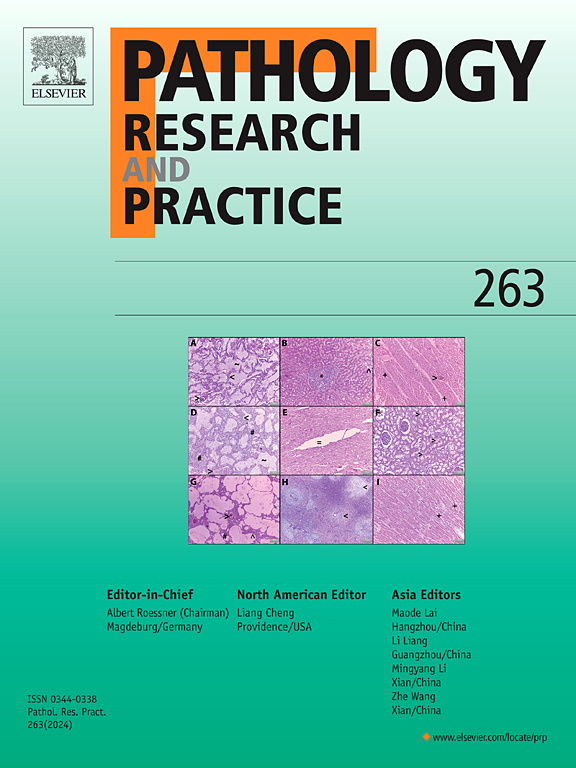Phosphaturic mesenchymal tumors: A pathological perspective
IF 3.2
4区 医学
Q2 PATHOLOGY
引用次数: 0
Abstract
Phosphaturic mesenchymal tumors (PMTs) are a rare group of neoplasms most commonly associated with tumor-induced osteocalcin (TIO), a paraneoplastic syndrome that profoundly impairs quality of life. Because the clinical manifestations are nonspecific, diagnosis is often delayed. PMTs are characterized by recurrent molecular alterations, most notably FN1::FGFR1 and KL (Klotho/α-Klotho) rearrangements. Tumor cells secrete fibroblast growth factor 23 (FGF23), which disrupts phosphate homeostasis and results in hypophosphatemia, thereby causing bone pain, fragility fractures, and skeletal deformities. Advanced imaging techniques play a central role in localizing the tumor, while complete surgical resection remains the most effective curative approach. Pathological evaluation provides the diagnostic gold standard; however, both clinical and histological features are heterogeneous, and the criteria for malignancy are not yet well defined. Furthermore, the biological significance of tumor margins remains an open question. This review summarizes the clinical presentation, molecular pathogenesis, pathological features, diagnostic strategies, therapeutic options, and prognostic implications of PMTs, highlighting current challenges and areas for future investigation.
磷化间充质肿瘤:病理学观点。
磷化间充质肿瘤(pmt)是一类罕见的肿瘤,通常与肿瘤诱导的骨钙素(TIO)相关,这是一种严重损害生活质量的副肿瘤综合征。由于临床表现非特异性,诊断往往被延误。pmt以复发性分子改变为特征,最明显的是FN1::FGFR1和KL (Klotho/α-Klotho)重排。肿瘤细胞分泌成纤维细胞生长因子23 (FGF23),破坏磷酸盐稳态,导致低磷血症,从而引起骨痛、脆性骨折和骨骼畸形。先进的成像技术在肿瘤定位中起着核心作用,而完全的手术切除仍然是最有效的治疗方法。病理评价提供诊断金标准;然而,临床和组织学特征是异质性的,恶性肿瘤的标准还没有很好的定义。此外,肿瘤边缘的生物学意义仍然是一个悬而未决的问题。本文综述了pmt的临床表现、分子发病机制、病理特征、诊断策略、治疗选择和预后影响,并强调了当前的挑战和未来研究的领域。
本文章由计算机程序翻译,如有差异,请以英文原文为准。
求助全文
约1分钟内获得全文
求助全文
来源期刊
CiteScore
5.00
自引率
3.60%
发文量
405
审稿时长
24 days
期刊介绍:
Pathology, Research and Practice provides accessible coverage of the most recent developments across the entire field of pathology: Reviews focus on recent progress in pathology, while Comments look at interesting current problems and at hypotheses for future developments in pathology. Original Papers present novel findings on all aspects of general, anatomic and molecular pathology. Rapid Communications inform readers on preliminary findings that may be relevant for further studies and need to be communicated quickly. Teaching Cases look at new aspects or special diagnostic problems of diseases and at case reports relevant for the pathologist''s practice.

 求助内容:
求助内容: 应助结果提醒方式:
应助结果提醒方式:


